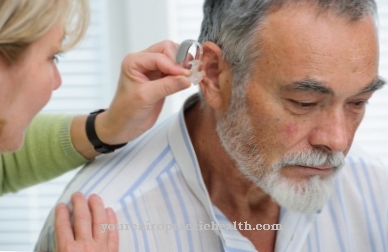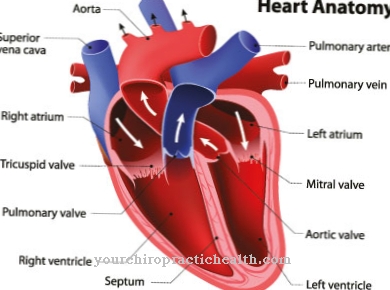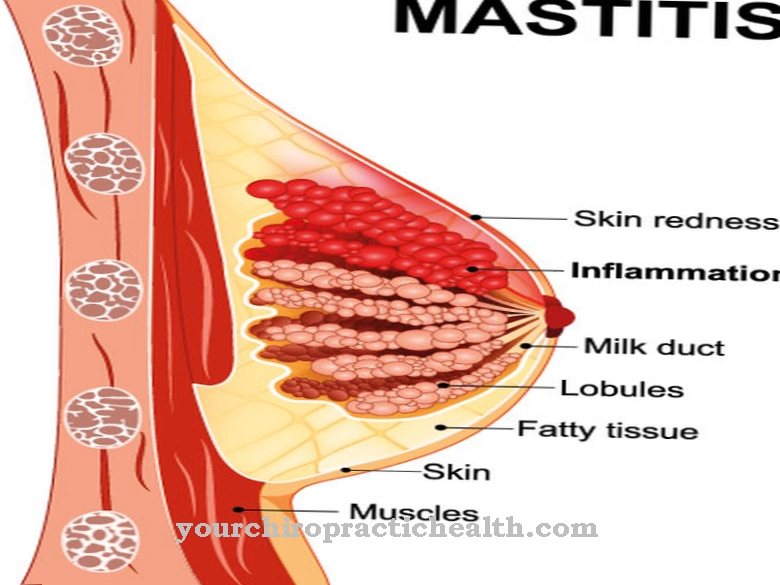The Osteoarthritis of the shoulder occurs less often than osteoarthritis of the knee, for example, but it is just as painful and the sufferer is extremely suffering. The disease cannot be cured. But there are numerous ways to alleviate the symptoms that can help the patient. The last resort if the disease progresses can be an operation.
What is shoulder osteoarthritis?
.jpg)
© bilderzwerg - stock.adobe.com
Osteoarthritis of the shoulder is a change in the shoulder joint caused by wear and tear. Between the upper arm and the shoulder socket, which together form the shoulder joint, there is a gap that is filled with cartilage.
This cartilage has the task of cushioning the pressure that arises when two bones meet at a joint and distributing the load evenly. If the cartilage mass becomes less due to wear, the two joint parts rub increasingly closer together. This friction causes further wear and tear, inflammation and pain.
causes
Since the shoulder joint is normally less stressed than the hip or knee joint, for example, which constantly have to carry and move the weight of the entire body, it is less likely to suffer from osteoarthritis than other joints.
If the disease occurs anyway, it can have various causes. Osteoarthritis is very often a phenomenon of advancing age and the associated wear and tear on the joints. But it can also be the result of an accident, for example after a badly healed fracture in the upper arm, or a disease such as rheumatism, a circulatory disorder or a bacterial inflammation.
Family predisposition can also play a role. Regular, one-sided stress, such as during sport or at work, can also lead to shoulder osteoarthritis after a long period of time. This can affect craftsmen as well as musicians or professional athletes.
Symptoms, ailments & signs
Osteoarthritis of the shoulder begins gradually and initially causes little discomfort. The patient does feel pain every now and then, but does not feel restricted in his actions and movements. If left untreated, the pain worsens and leads to restricted mobility.
Working overhead in particular often seems impossible. The restrictions on movement arise in all directions. The arm can no longer be spread apart and reaching upwards will only be possible with pain.
Especially those who are active in sports and often put pressure on the shoulder will feel the pain and will no longer be able to put pressure on the shoulder as usual. Sports in particular, where the focus is on the shoulder, will then only be possible with pain. These include handball, tennis, shot put and volleyball.
The pain is worst when there is weight on the shoulder and when the person is lying on the shoulder. In the case of advanced shoulder osteoarthritis, the joint hurts even at rest. If the patient restricts his movements more and more, frozen shoulder occurs. Timely treatment of shoulder osteoarthritis is advisable so that the symptoms do not continue to increase and become chronic.
Diagnosis & course
_2.jpg)
In the case of osteoarthritis of the shoulder, the upper arm and shoulder socket rub against each other without being adequately protected by the cartilage in the joint. The consequence of this is pain from the mechanical friction, later inflammation can also arise due to the lack of pressure compensation.
At first, the patient feels the movement of the arm, shoulder or head as painful. A relieving posture is then often adopted, which leads to a poor posture and incorrect stress on other muscles and joints and leads to further pain. The mobility of the shoulder joint is severely restricted as the disease progresses; ultimately, the person affected also feels pain when resting or while sleeping.
The joint can completely lose its mobility and stiffen. Daily tasks like getting dressed can be made more difficult. For the diagnosis, a detailed description of the symptoms and complaints is useful in an initial discussion. A physical exam can check the mobility of the joint.
An ultrasound examination, an X-ray and a magnetic resonance tomography (MRT) confirm whether there is actually shoulder osteoarthritis and the extent to which the wear and tear on the bones and cartilage has already progressed. If it is suspected that a bacterial or rheumatic disease is the cause, a puncture of the joint is appropriate.
With osteoarthritis of the shoulder, the person affected must expect complications. These include primarily joint inflammation. Doctors then speak of activated osteoarthritis. It is manifested by increased pain and swelling of the shoulder joint.
Complications
Complications resulting from omarthrosis often have an impact on patients' daily lives. They often suffer from restrictions on their freedom of movement and stabbing pain. As a result, the person concerned can no longer carry out normal everyday things unhindered. If there is additional stress on the shoulder joint, there is a risk of bone damage in the further course. There is a risk that the bone will split off due to the intense friction, causing permanent damage.
How often complications arise with shoulder osteoarthritis and to what extent they occur varies from person to person. This means that pain-free periods of a few months are just as possible as the disease can progress rapidly. To avoid serious sequelae, it makes sense to consult a doctor in order to start treatment at an early stage. Surgical intervention may also be required at times.
A rare sequela of surgery is inflammation, which in turn causes an abscess. Pus collects in a small cavity. This cavity in turn creates pressure on the neighboring tissue. In some cases, the pus penetrates into the bloodstream, so there is a risk of blood poisoning (sepsis).
When should you go to the doctor?
In the case of shoulder osteoarthritis, the person concerned is always dependent on a visit to a doctor in order to avoid further complications and complaints. Only through early diagnosis and treatment of this disease can further symptoms be prevented. A doctor should be consulted if the patient suffers from very severe restrictions in movement on the shoulders. Even slight and simple movements of the shoulders lead to severe pain, which can have a negative effect on everyday life and also on the quality of life of the person concerned.
It is not uncommon for the pain to spread to the neighboring regions of the body. If the pain caused by shoulder osteoarthritis persists and does not go away on its own, a doctor must be consulted in any case. Consult a doctor especially after an accident or severe injury.
A general practitioner or an orthopedic surgeon can be consulted for shoulder osteoarthritis. In most cases the disease progresses positively.
Treatment & Therapy
Shoulder arthrosis is incurable.Acute complaints can be reduced by injecting painkillers and cortisone, and cold treatments are also felt to be soothing.
If inflammation in the stressed joint areas has healed through medication and the patient has been largely free of pain, physiotherapy is possible. Through targeted exercises, incorrect posture can be corrected and muscles and tendons can be strengthened in order to relieve the skeleton as best as possible. X-ray stimulation, microwave radiation and ultrasound can slow the progression of osteoarthritis.
At a later stage, the shoulder joint can be cleaned by means of an arthroscopy and, in the course of this procedure, the sacrum may be removed. If the joint is no longer in a condition worth preserving, it may be advisable to insert a prosthesis. The doctor decides together with the patient in each individual case which type of artificial joint makes the most sense. This essentially depends on the degree of damage to the shoulder joint.
The procedure is usually performed under general anesthesia and requires several weeks of rehabilitation. After about three months, the first daily load on the shoulder is possible again. Such a prosthesis lasts about ten years on average.
prevention
Like any other osteoarthritis, shoulder osteoarthritis can be prevented through exercise. Stretching and warm-up exercises are particularly important. Sports such as swimming or cycling, which require regular processes and involve different areas of the muscles, are very suitable.
Unilateral loads should be avoided. Movement generally promotes blood flow to the cartilage and thus its lifespan. Strong muscles also support the skeleton and help to relieve the bones. Eating a healthy diet and maintaining a normal weight are also important to keep the joints healthy.
Aftercare
Since shoulder osteoarthritis cannot be cured, the patient will have to look after his diseased shoulder for a lifetime. Even after an operation, which can usually relieve the symptoms, there is no guarantee that osteoarthritis in the shoulder area will not recur.
Therefore, in the follow-up care, the recommendations remain as they are given for self-help and for prevention. Muscle parts in the shoulder area, for example, should not be tensed on one side. For example, you can create the workplace ergonomically and otherwise ensure sufficient breaks with appropriate relaxation.
Age-appropriate exercise is essential for shoulder osteoarthritis patients. The stretching exercises already learned through physiotherapy treatments should be continued. In addition, stretching courses, yoga or Pilates are recommended. Anything that strengthens the muscles in the shoulder, neck, back and arm area is also good. Physiotherapy or massages are advisable.
A healthy diet is also important. After all, the body's immune system must be able to fight off inflammation and compensate for wear and tear. It can only do that if it is strengthened accordingly. A varied diet rich in vitamins ensures a strong immune system. In order not to destroy this effect, patients should avoid stimulants such as alcohol and nicotine.
You can do that yourself
Shoulder arthrosis (omarthrosis) is a disease that can be positively influenced by self-help, but is just as incurable as by conventional conventional medical treatment. The reason for this is the joint surfaces, the destruction of which cannot be reversed. Nevertheless, an attempt can be made to stimulate the formation of synovia (joint fluid) through targeted movement so that its gliding ability ensures that the joint surfaces do not rub too hard on one another. Movement stimulates the synovia in the joint space. This can bring some relief.
Movement is, however, of central importance in the context of self-help with shoulder osteoarthritis for another reason: If pain prompts the patient to take care of the joint, it threatens to stiffen and the pain (including immobility) increases. This vicious cycle must be avoided at all costs and the cooperation of the patient is essential in this context. Exercises that train the rotator cuff are particularly important. These and others can be learned from the physiotherapist and regularly carried out at home on your own.
There are two other things that patients should be aware of with osteoarthritis of the shoulder. One-sided postures and movements are to be avoided. It is also important to take a look at ergonomics in the workplace. Relaxation during work breaks is also an important factor here. Furthermore, care should be taken to ensure a comfortable position in bed with a shoulder-sized mattress at night.






.jpg)




















